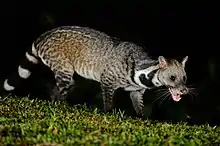Viverra
Viverra is a mammalian genus that was first named and described by Carl Linnaeus in 1758 as comprising several species including the large Indian civet (V. zibetha).[2] The genus was subordinated to the viverrid family by John Edward Gray in 1821.[3]
| Viverra Temporal range: | |
|---|---|
 | |
| Illustration of Large Indian civet (Viverra zibetha) | |
| Scientific classification | |
| Domain: | Eukaryota |
| Kingdom: | Animalia |
| Phylum: | Chordata |
| Class: | Mammalia |
| Order: | Carnivora |
| Suborder: | Feliformia |
| Family: | Viverridae |
| Subfamily: | Viverrinae |
| Genus: | Viverra Linnaeus, 1758 |
| Type species | |
| Viverra zibetha | |
| Species | |
|
see text | |
Characteristics
Viverra species are distinguished externally from the other genera of the Viverrinae by the structure of the fore feet: the third and fourth digits have lobes of skin, which act as protective sheaths for the retractile claws. The pads of the feet are surrounded by hair. They have a long and narrow skull, with narrow, nearly parallel-sided, not strongly constricted waist. Their postorbital processes are small and a little in front of the middle point between the tip of the premaxillae in front and of the occipital crest behind. The sagittal crest is moderately strong in adults. The sub-orbital portion of the cheek is comparatively short. The suture between the anterior bone of the zygomatic arch and the maxilla is much shorter than the median length of the nasals, than half the length of the cheek-teeth, and than the width across the occipital condyles. This width exceeds the length of the compound auditory bulla.[4]
Living species
| Name | Distribution | Image |
|---|---|---|
| Large Indian civet (V. zibetha) Linnaeus, 1758 | Southern slopes of the Eastern Himalaya in Nepal, Bhutan and northeastern India to Southeast Asia[5] |  |
| Malayan civet (V. tangalunga) Gray, 1832[6] | Indonesia (Sumatra, Bangka Island, Borneo, the Riau Islands-Lingga Archipelago) and the Philippines[7] |  |
| Malabar large-spotted civet (V. civettina) Blyth, 1862[8] | Western Ghats in India[9] | |
| Large-spotted civet (V. megaspila) Blyth, 1862[8] | Myanmar, Thailand, Malaysia, Cambodia, Laos, Vietnam and China[10] | .jpg.webp) |
References
- "Viverra". Paleobiology Database.
- Linnaeus, C. (1758). "Viverra". Caroli Linnæi Systema naturæ per regna tria naturæ, secundum classes, ordines, genera, species, cum characteribus, differentiis, synonymis, locis. Tomus I. (Editio decima, reformata ed.). Holmiae: Laurentii Salvii. pp. 43–44.
- Gray, J. E. (1821). "On the natural arrangement of vertebrose animals". London Medical Repository. 15 (1): 296–310.
- Pocock, R. I. (1939). "Genus Viverra Linnaeus". The Fauna of British India, including Ceylon and Burma. Mammalia. – Volume 1. London: Taylor and Francis. pp. 344–354.
 One or more of the preceding sentences incorporates text from this source, which is in the public domain.
One or more of the preceding sentences incorporates text from this source, which is in the public domain. - Timmins, R. J.; Duckworth, J. W.; Chutipong, W.; Ghimirey, Y.; Willcox, D. H. A.; Rahman, H.; Long, B. & Choudhury, A. (2016). "Viverra zibetha". IUCN Red List of Threatened Species. 2016: e.T41709A45220429. Retrieved 29 October 2018.
- Gray, J. E. (1832). "On the family of Viverridae and its generic sub-divisions, with an enumeration of the species of several new ones". Proceedings of the Committee of Science and Correspondence of the Zoological Society of London. 2: 63–68.
- Duckworth, J. W.; Mathai, J.; Wilting, A.; Holden, J.; Hearn, A. & Ross, J. (2016). "Viverra tangalunga". IUCN Red List of Threatened Species. 2016: e.T41708A45220284. Retrieved 30 October 2018.
- Blyth, E. (1862). "Report of Curator, Zoological Department, February 1862". The Journal of the Asiatic Society of Bengal. 31 (3): 331–345.
- Mudappa, D.; Helgen, K. & Nandini, R. (2016). "Viverra civettina". IUCN Red List of Threatened Species. 2016: e.T23036A45202281. Retrieved 30 October 2018.
- Timmins, R.; Duckworth, J. W.; WWF-Malaysia; Roberton, S.; Gray, T. N. E.; Willcox, D. H. A.; Chutipong, W. & Long, B. (2016). "Viverra megaspila". IUCN Red List of Threatened Species. 2016: e.T41707A45220097. Retrieved 30 October 2018.